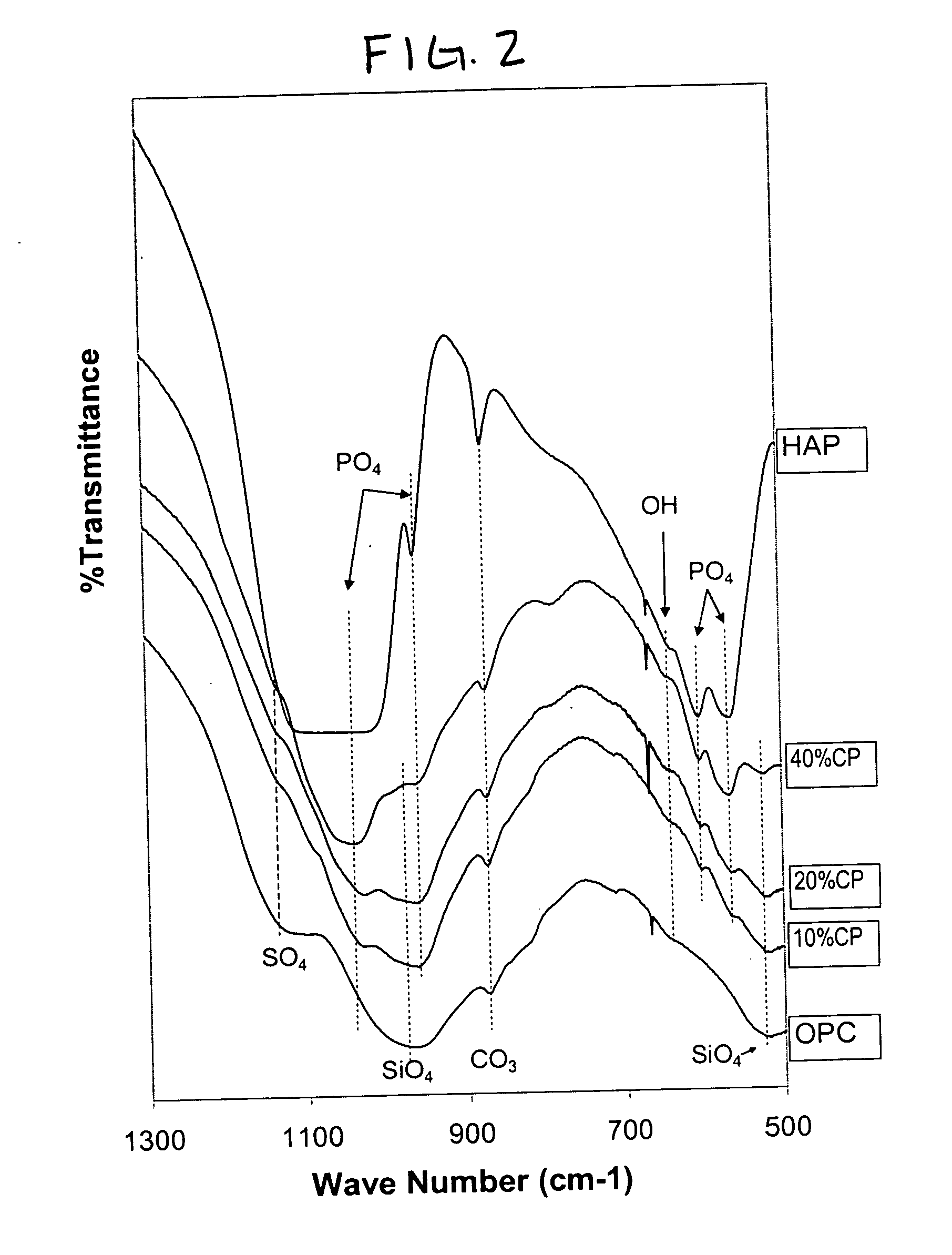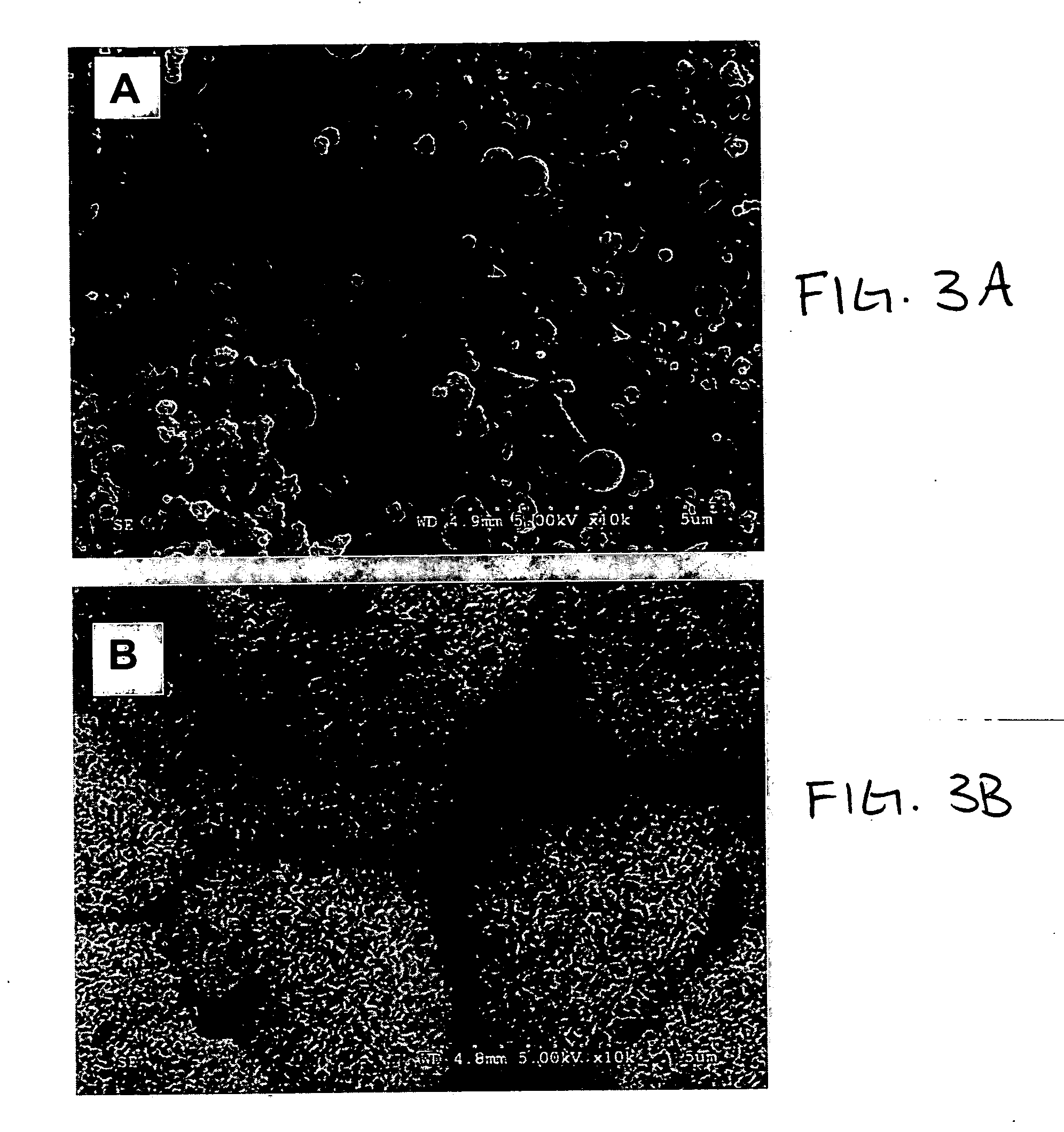High strength biological cement composition and using the same
a biological cement and composition technology, applied in cement production, medical science, dentistry, etc., can solve the problems of unsuitable for many dental applications, negative effect of set cement quality, and present certain biocompatibility and toxicities, and achieve high mechanical strength, high bioactivity, and high biocompatibility
- Summary
- Abstract
- Description
- Claims
- Application Information
AI Technical Summary
Benefits of technology
Problems solved by technology
Method used
Image
Examples
example 1
Preparation of Novel High Strength Biocement for Orthopedic Applications
[0072] In this example the phosphate silicate cement was prepared synthetically using well defined, substantially pure chemicals (as opposed to the poorly defined minerals utilized for preparation of the typical commercial Portland cements). The raw materials used were colloidal silica (50 wt % Ludox, from 3M company) for the SiO2 component, calcium hydroxide (99.9%, Sigma-Aldrich) for the CaO component, tetracalcium phosphate (Ca4(PO4)2O), and dicalcium phosphate anhydrate (CaHPO4.H2O) (Fisher). The designed composition was 65 wt % tricalcium silicate, 20 wt % dicalcium silicate, 10 wt % tetracalcium phosphate, and 5 wt % dicalcium phosphate.
[0073] A 200 g cement batch was prepared by mixing 96.32 g of colloidal silica, 160.98 g calcium hydroxide, and 300 g distilled water in a ceramic jar, followed by ball milling for 24 hours. The slurry of this mixture was dried by using a spray dryer, and then fired in hi...
example 2
Preparation and Properties of Phospho-Silicate Hydraulic Cement by Sol-Gel Process
[0075] This example utilized a sol-gel process to prepare high-purity, aluminum-free biocement. Tetraethylorthosilicate (TEOS), Ca(NO3)2 4H2O, triethyl phosphate (TEP) were used in the sol-gel method. Ca(NO3)2 4H2O was dissolved in 1M HNO3 solution and TEOS was added to the solution with vigorous stirring to obtain a nominal composition of 70 mol % CaO-30% SiO2. After 10-15 min of hydrolysis under stirring, a homogenous sol was obtained. The sol precursor was sealed in a container, where the precursor was allowed to gel for 1 day at room temperature and aged for another day at 70° C. The dry gel powder was obtained by heating the templated gel at 600° C. in air for 1 hour (heating rate: 2° C. / min). The dry powder was fired at 1400° C. for 2 hrs. The crystalline product was analyzed by X-ray diffraction (XRD). The results of XRD indicated that the product contained only the phases of tricalcium silicat...
example 3
Effect of Calcium Phosphate on the Properties and Microstructure of Biocement
[0078] In this example, biocement was prepared in the same manner as described in Example 1. The setting time of was about 1 hour to 4 hours, for a water / cement ratio of 0.25. The average compressive strength after 7-days incubation at 37° C. and 100% humidity was 104 MPa, with the standard deviation of 7 MPa, as shown in FIG. 1.
[0079] The X-ray diffraction pattern provided in FIG. 6 indicates that the set cement contained about 15% HAP, and about 8% Ca(OH)2. This is compared with the characteristics of the control samples without calcium phosphate material, hydrated under identical conditions as the above samples of biocement. The average compressive strength of calcium silicate control cement was 45 MPa, with a standard deviation of 5 MPa, again referring to FIG. 1. The X-ray diffraction pattern provided in FIG. 6 indicates that the set control sample contained no HAP, and about 20% of Ca(OH)2. The scan...
PUM
| Property | Measurement | Unit |
|---|---|---|
| Fraction | aaaaa | aaaaa |
| Fraction | aaaaa | aaaaa |
| Fraction | aaaaa | aaaaa |
Abstract
Description
Claims
Application Information
 Login to View More
Login to View More - R&D
- Intellectual Property
- Life Sciences
- Materials
- Tech Scout
- Unparalleled Data Quality
- Higher Quality Content
- 60% Fewer Hallucinations
Browse by: Latest US Patents, China's latest patents, Technical Efficacy Thesaurus, Application Domain, Technology Topic, Popular Technical Reports.
© 2025 PatSnap. All rights reserved.Legal|Privacy policy|Modern Slavery Act Transparency Statement|Sitemap|About US| Contact US: help@patsnap.com



